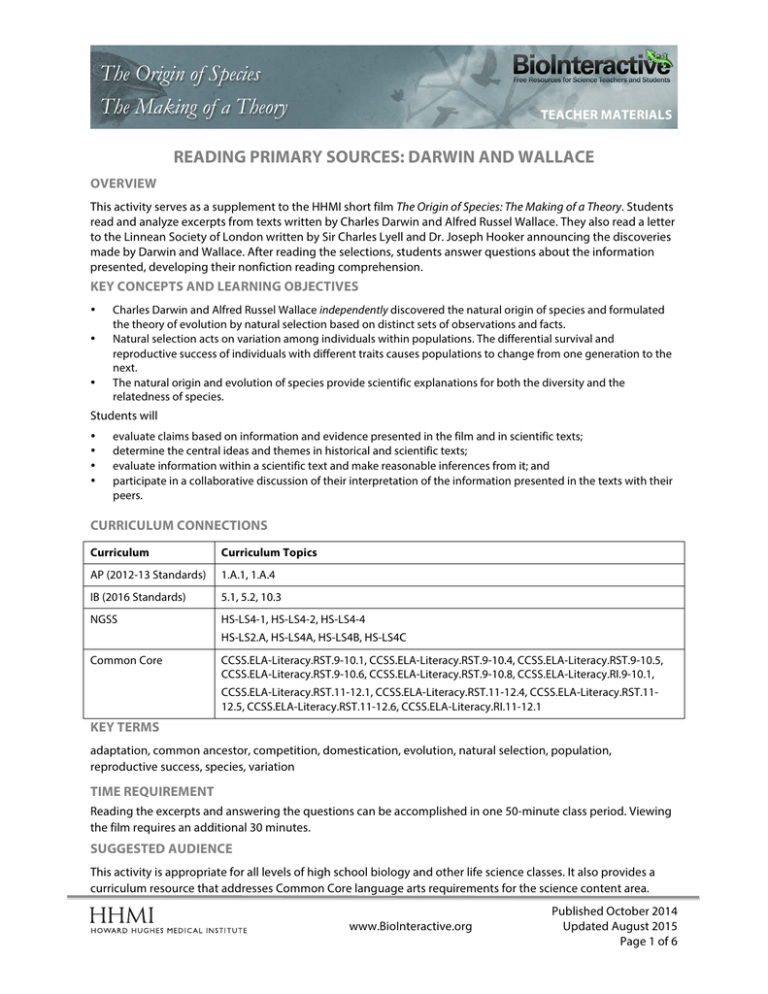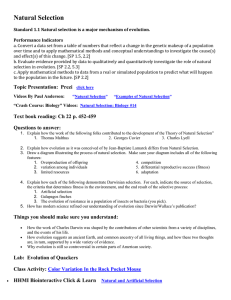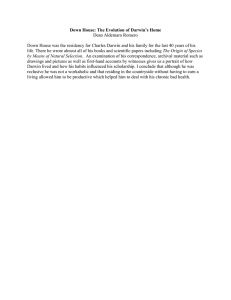The Origin of Species The Making of a Theory
advertisement

The Origin of Species The Making of a Theory TEACHER MATERIALS READING PRIMARY SOURCES: DARWIN AND WALLACE OVERVIEW This activity serves as a supplement to the HHMI short film The Origin of Species: The Making of a Theory. Students read and analyze excerpts from texts written by Charles Darwin and Alfred Russel Wallace. They also read a letter to the Linnean Society of London written by Sir Charles Lyell and Dr. Joseph Hooker announcing the discoveries made by Darwin and Wallace. After reading the selections, students answer questions about the information presented, developing their nonfiction reading comprehension. KEY CONCEPTS AND LEARNING OBJECTIVES • • • Charles Darwin and Alfred Russel Wallace independently discovered the natural origin of species and formulated the theory of evolution by natural selection based on distinct sets of observations and facts. Natural selection acts on variation among individuals within populations. The differential survival and reproductive success of individuals with different traits causes populations to change from one generation to the next. The natural origin and evolution of species provide scientific explanations for both the diversity and the relatedness of species. Students will • • • • evaluate claims based on information and evidence presented in the film and in scientific texts; determine the central ideas and themes in historical and scientific texts; evaluate information within a scientific text and make reasonable inferences from it; and participate in a collaborative discussion of their interpretation of the information presented in the texts with their peers. CURRICULUM CONNECTIONS Curriculum Curriculum Topics AP (2012-13 Standards) 1.A.1, 1.A.4 IB (2016 Standards) 5.1, 5.2, 10.3 NGSS HS-LS4-1, HS-LS4-2, HS-LS4-4 HS-LS2.A, HS-LS4A, HS-LS4B, HS-LS4C Common Core CCSS.ELA-Literacy.RST.9-10.1, CCSS.ELA-Literacy.RST.9-10.4, CCSS.ELA-Literacy.RST.9-10.5, CCSS.ELA-Literacy.RST.9-10.6, CCSS.ELA-Literacy.RST.9-10.8, CCSS.ELA-Literacy.RI.9-10.1, CCSS.ELA-Literacy.RST.11-12.1, CCSS.ELA-Literacy.RST.11-12.4, CCSS.ELA-Literacy.RST.1112.5, CCSS.ELA-Literacy.RST.11-12.6, CCSS.ELA-Literacy.RI.11-12.1 KEY TERMS adaptation, common ancestor, competition, domestication, evolution, natural selection, population, reproductive success, species, variation TIME REQUIREMENT Reading the excerpts and answering the questions can be accomplished in one 50-minute class period. Viewing the film requires an additional 30 minutes. SUGGESTED AUDIENCE This activity is appropriate for all levels of high school biology and other life science classes. It also provides a curriculum resource that addresses Common Core language arts requirements for the science content area. www.BioInteractive.org Published October 2014 Updated August 2015 Page 1 of 6 The Origin of Species The Making of a Theory TEACHER MATERIALS PRIOR KNOWLEDGE It would be helpful for students to: • • be familiar with the theory of evolution based on natural selection; and be familiar with the scientific process of testing ideas using evidence. PROCEDURE 1. Before doing this activity, students should view the film The Origin of Species: The Making of a Theory. They can view the film in class or as a homework assignment. 2. When you introduce this activity, explain that students will read and analyze excerpts from Darwin’s and Wallace’s original writings as well as a letter written by two of Darwin’s colleagues, Sir Charles Lyell and Dr. Joseph Hooker. Both Lyell and Hooker made significant scientific contributions. Lyell authored an important text, Principles of Geology, and popularized the concept of uniformitarianism. Hooker is famous for his work as a botanist. 3. There are two ways this activity can be used. One option is to have students work in pairs to read through the texts, discuss what the author of the excerpt is saying, and answer the questions. The second option is to have students complete the assignment for homework and be prepared to discuss their answers in class. 4. At the end of the activity, discuss with the class how the information contained in these excerpts is similar to or different from what is presented in the film. Ask students to provide evidence from their readings that Darwin and Wallace independently formulated the theory of evolution by natural selection. TEACHING TIPS • • • • • Discuss with students the importance of reading primary sources in understanding historical accounts and evaluating scientific findings. Students might need context for the readings. • Provide students with additional information about the Linnean Society of London, which is the world’s oldest and most revered society for the study of taxonomy and natural history. Discuss why it was important for Darwin’s and Wallace’s papers to be read during a meeting of the society. Students can relate this to the present-day practice of peer review. • Additional information about the history leading up to Wallace’s and Darwin’s discoveries is provided in the In-Depth Guide. Consider providing students with a copy of the background information in the guide. The readings contain advanced vocabulary; some students will need extra support and modifications. While some words are defined on the student handout, consider having students keep a separate list of words that they find challenging and then using different strategies (brainstorming definitions with peers or simply using a dictionary) to define them. Consider doing the activity as a series of dramatic readings, acting out a meeting of the Linnean Society. Choose students to read the passages aloud and then give groups time to answer the questions. If you wish to have students write a complete paragraph as an answer to question 10, a paragraph evaluation rubric is included at the end of this teacher document. www.BioInteractive.org Published October 2014 Page 2 of 6 The Origin of Species The Making of a Theory TEACHER MATERIALS ANSWER KEY READING 1: WHO GETS CREDIT? 1. a. What words did Lyell and Hooker use to describe Darwin’s and Wallace’s theory in their letter to the Linnean Society? They defined the theory as a ”very ingenious theory to account for the appearance and perpetuation of varieties and of specific forms on our planet.” b. How would you rephrase what they wrote in your own words? Students’ answers will vary, but a possible answer might say “It was a very innovative theory to explain the origin and existence of the variations within species and of species themselves on Earth.” 2. Make a claim about who Lyell and Hooker thought should receive credit for formulating the theory. Provide evidence from the text to support your claim. Claim: Lyell and Hooker gave credit to both Darwin and Wallace. Evidence: Lyell and Hooker wrote that Darwin and Wallace “independently and unknown to one another, conceived the same very ingenious theory,” and they “may both fairly claim the merit of being original thinkers in this important line of inquiry.” Lyell and Hooker knew that Darwin had been working on his theory of evolution for decades; they explain that Darwin “had himself written on the same subject, and which, as before stated, one of us had perused in 1844, and the contents of which we had both of us been privy to for many years.” No one realized that Wallace had reached much the same conclusion as Darwin regarding the origin of species. Students will not know that as a result, both men received credit with the recognition that Darwin had been working on the topic for longer than Wallace. 3. What reasons do Lyell and Hooker give for wanting to make the writings of Darwin and Wallace public? Provide evidence from the text in your answer. 1) Papers from both Darwin and Wallace were read in an attempt to be fair—in recognition that both men had come to the same conclusions independently. 2) Lyell and Hooker said they wanted to make these ideas public “in the interest of science” so that “views founded on a wide deduction from facts, and matured by years of reflection, should constitute at once a goal from which others may start.” www.BioInteractive.org Published October 2014 Page 3 of 6 The Origin of Species The Making of a Theory TEACHER MATERIALS READING 2: HOW DOES NATURAL SELECTION WORK? 4. Complete the following chart for the excerpt from Darwin’s paper. Provide examples of evolution by natural selection that Darwin used in his writing. Describe the species, the variations among individuals, the selective pressure, and how species change over time. Darwin—Natural Selection Example 1 Example 2 Species dogs/foxes plants What trait varies in the species? heavy or light form, limb length, eyesight plumed seeds with more or less down What is the selective pressure? (In other words, what causes some individuals to produce more offspring than others?) When the rabbit/hare population was down, dogs with light form, longer limbs, and better eyesight would be more likely to obtain adequate food, survive, and rear more young. More down would allow for greater dissemination and a greater number of seeds would germinate. How would the population change over time? The number of dogs with these favorable traits would increase. The number of plants with more down would increase. 5. Complete the following chart for the exerpt from Wallace’s paper. Provide examples of evolution by natural selection that Wallace used in his writing. Describe the species, the variations among individuals, the selective pressure, and how species change over time. Wallace —Natural Selection Example 1 antelope Example 2 passenger pigeons What trait varies in the species? leg length and strength wing power What is the selective pressure? (In other words, what causes some individuals to produce more offspring than others?) Antelopes with shorter, weaker legs would fall prey to carnivores. They would therefore be less likely to produce offspring. Pigeons with weak wings would likely obtain less food and be less likely to live and produce offspring. How would the population change over time? The number of antelopes with short, weak legs in the population would decrease over time, while the number of antelopes with long, strong legs would increase. The number of pigeons with weak wings in the population would decrease over time, while the number of those with stronger wings would increase. Species www.BioInteractive.org Published October 2014 Page 4 of 6 The Origin of Species The Making of a Theory TEACHER MATERIALS READING 3: VARIATION AS A SOURCE OF EVIDENCE FOR NATURAL SELECTION 6. How is variation in wild and domesticated species evidence for natural selection? In the wild, the greater struggle for survival causes many variations to be eliminated since they do not increase an individual’s chances to survive and reproduce. Hence, these unfavorable variations are not passed on to many offspring and do not increase in frequency. Humans select certain traits in domesticated species. These traits are passed on to offspring since we protect the animals and plants that have these variations. By way of explanation, Wallace writes that white blackbirds do not survive in the wild but do when kept by humans. 7. According to Wallace, why do domesticated species exhibit more variability than wild species? Support your answer with evidence from the passage. Wallace wrote that sports [mutants] such as white blackbirds and stump-tailed cats increase in number under domestication but not in the wild because in the wild these mutants are “eliminated through the struggle for survival—that is by natural selection.” Darwin also alluded to the struggle for survival being more intense in the wild than under domestication. READING 4: WHAT IS A SPECIES? 8. a. In your own words, define “species” based on the excerpt of Wallace’s writing. A species is defined as a group of individuals that freely breed together and produce fertile offspring. b. Based on this definition, how does the infertility of mules argue that the common ass, the kiang, and the zebra are separate species? A mule is not considered a species because it cannot reproduce. Zebra, kiang, and the common ass are separate species since a zebra and a kiang or a common ass cannot mate and produce fertile offspring. 9 a. Darwin writes that the tapir and horse are different species but share a common ancestor. What does he predict this common ancestor would have looked like? Darwin writes that a horse and a tapir, which are two distinct species, descended from a common ancestor that did not look like either a horse or a tapir but probably had some features common to both. b. Using the horse and tapir, make a diagram similar to the one Darwin used in Chapter 4 of On the Origin of Species. Be sure to label the “common ancestor.” Students’ drawings will vary. Here is an example 10. From all these readings, is there evidence that both Darwin and Wallace independently formulated the theory of evolution by natural selection? Support your answer. Answers will vary. Most students will likely respond that there is evidence that Wallace and Darwin independently formulated the theory of evolution by natural selection. Both Darwin and Wallace wrote about the presence of variations within a species and that some of these variations enable members of the species to better compete in the struggle for survival. Both wrote that those individuals with www.BioInteractive.org Published October 2014 Page 5 of 6 The Origin of Species The Making of a Theory TEACHER MATERIALS favorable variations live to reproduce, passing on their favorable traits, while those with less favorable traits are eliminated. PARAGRAPH EVALUATION RUBRIC The following simple rubric can be used to evaluate the students’ paragraphs. Teachers are encouraged to use rubrics provided by their schools. Alternatively, rubrics very closely aligned with the Common Core are available at http://www.smarterbalanced.org. 1 2 3 4 Purpose & Organization WHST.9-10.2a Neither the purpose nor the organization is clear. The paragraph's purpose is not clear and/or the organization is weak. The paragraph has a clear purpose, but the organization is not optimal. The paragraph has a clear purpose and the organizational structure supports that purpose throughout. Supporting Facts & Details WHST.9-10.2b Little or no evidence is included. Only some evidence, details, and facts are included in an attempt to support the main idea. Adequate evidence, details, and facts are included and generally support the main idea. Multiple lines of evidence, details, and facts are included and elaborated to effectively strengthen the arguments or main idea. Transitions WHST.9-10.2c Transitions between ideas are lacking. Transitions are infrequent or ineffective. Transitions are present but are not strong. Transitions between sentences and ideas flow well. Precise Language & Jargon WHST.9-10.2d Wording is confused or unclear. Simple terms are used and piece is mostly clear. Conventions Errors are found throughout and make the piece difficult to understand. Many errors in punctuation, capitalization, spelling, and sentence structure. Some scientific terms are used, but the piece is easy to understand. Some errors in punctuation, capitalization, spelling, and sentence structure. Precise scientific language is used correctly; the piece is clear. Few or no errors in punctuation, capitalization, spelling, and sentence structure. AUTHOR Written by Mary Colvard, Cobleskill-Richmondville High School (retired) Reviewed by Paul Beardsley, PhD Edited by Susan Dodge and Laura Bonetta, PhD, HHMI; Copyedited by Linda Felaco www.BioInteractive.org Published October 2014 Page 6 of 6


